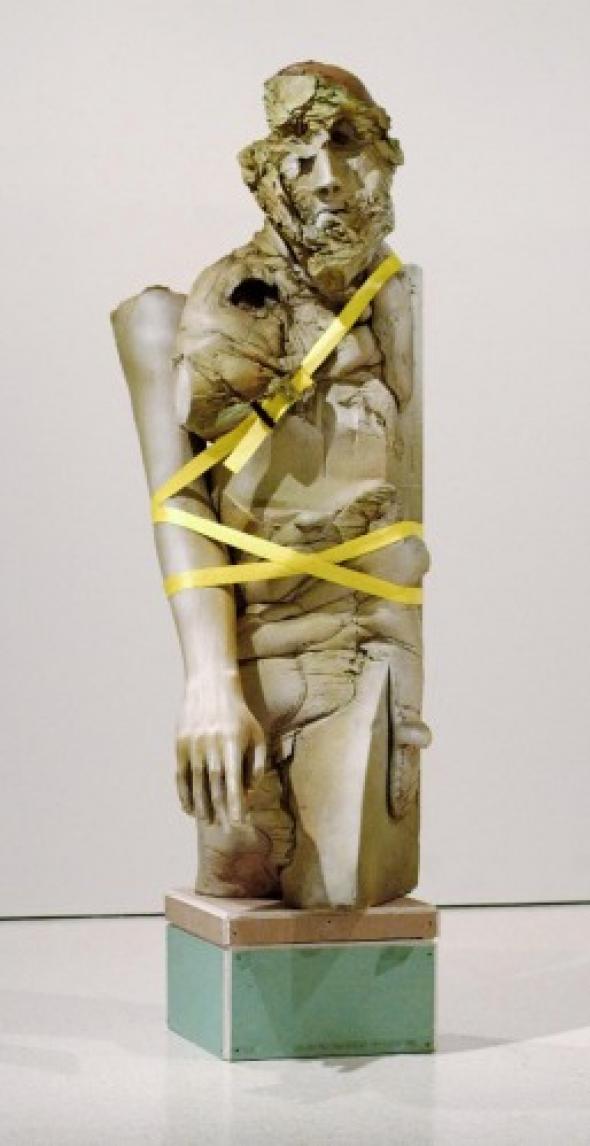Any Other But Our Selves
Contemporary curators are loving the alien, the sacred and the cultic. But far from challenging contemporary social mores, this Other-worship is just an orthodox postmodern denigration of human agency, argues J.J. Charlesworth
It might have been coincidental that this year two big international group shows should look to Mars for their curatorial pretext. In London, the Barbican's spring show The Martian Museum of Terrestrial Art opened only a day after the latest incarnation of the Carnegie International - at Pittsburgh's Carnegie Museum of Art - which was subtitled Life on Mars. The two shows proposed superficially different uses of the metaphor of extraterrestrial life to reflect on contemporary artistic practice, yet underlying these apparent differences, one could detect common themes that are now strongly influential in Western culture - that of a pessimistic apprehension of impending disaster; a profound sense of uncertainty and disorientation regarding human society's claim to progressive agency; and a kind of post-historical estrangement from the experience of modernity. What drives these, however, is a now common theoretical and political celebration of what might be called the Absolute Other. Along with the more recently opened mega-show After Nature at New York's New Museum, these shows all share a peculiar critical operation - the use of a strategy of displacement of the human subject from which to ‘look back' or ‘look from afar' on human life. Or, as contemporary theoretical jargon would have it, the effect of transposition that results from the attempt to occupy the position of ‘the Other'. In their attachment to the Other, these shows reveal a common distrust of, and estrangement from, that much maligned humanist concept, the Subject. It's an assimilation of earlier post-structuralist critiques which manifests itself as a form of extreme scepticism regarding the legitimacy of human subjectivity - psychological, cultural and social - and as a consequence, it is the legitimacy of human agency in toto that is effectively called into question.
But while these big offerings tend to share a very liberal sense of melancholia, other more apparently radical positions work over similar ground. In London, Pil and Galia Kollectiv's show The Institute of Psychoplasmics, at Pumphouse Gallery, proposed a more theoretically explicit use of the Subject-Other division, in which the notion of the ‘cult' is mobilised as absolute Other, as a critique of a Subject synonymous with Capitalism. Nevertheless, whether appealing to mainstream culture's misanthropic liberal anxieties, or claiming a site of monadic exclusion from the Subject, these recent curatorial positions propose the Subject and human subjectivity as something to be escaped, denied and criticised from outside. Yet this throws up a paradox; who is this absolute Other who claims alterity, if not another, still-present Subject?
In Martian Museum, the critique of the Subject was conducted on the terms already long-established by the post-colonial critique of the Other; here, Martians were substituted for the position of the ethnocentric Western Subject; gazing on the works of Western contemporary art as if these were the artefacts that Western anthropology has long designated as the products of the ‘primitive' Other. As curator Francesco Manacorda confidently declares in his introduction to the Martian Museum's catalogue:
The Martian perspective allows for a reassessment of the art object from an alien standpoint: thus mimicking the way that Western anthropologists historically interpreted non-Western cultures through foreign eyes. Looking at art as though from outer space offers the potential to make the familiar strange and to turn the dominant Euro-American art tradition into the ‘other'.1
However, the explicit political motive that underpins why one should want to perform such an act of ‘othering' is is spelt out by the Barbican's directors in their preface:
In parodying the way that Western anthropologists, ethnographers, and art historians have historically viewed non-Western culture through alien eyes, [Martian Museum] questions the hubris of any culture's pretence to fully understand another, through the acquisition of objects and their didactic display in a museum.2
The notion of Otherness is here presented as an insuperable barrier to the understanding of other cultures, as well as typifying the ‘hubristic' hegemony of the Western gaze, which is why it is easy for the writers to turn the gaze into something ‘alien'. It may be more than a metaphor running away with itself, but to suggest that an ‘ethnocentric' Western gaze might see the ‘Other' as ‘alien' betrays something of how absolute the notion of the Other has now become in common discussions of cultural difference: if there were indeed aliens, only their ‘otherness' to our humanity could be so absolute.
What is unsettling in this casual use of the ‘alien' ‘Other' as a (self-) critical strategy against the ‘Western' subject is that cultural otherness between human cultures can - in reality - never be so immobile or absolute. The cultural dynamics of hybridity, heterogeneity and globalisation now challenge, more than ever, the Western hegemony that could generate the post-colonial critique of the Other in the first place. And the funny thing about Martian Museum is that the fictional Martian curators seem only to have looked for art in Europe and America. The contemporary reality of art's now rapidly-globalising modernity is nowhere to be found on their sensor instruments - Martian Museum is distinct in almost entirely excluding art from the modernising, industrial Far East.
Martian Museum is of course not so original. The critical excavation of the fantasy of the alien-as-Other, hooked up to a contemporary critique of ethnic difference, had already been made by the InIVA exhibition Alien Nation at the ICA in late 2006, a show which presented the work of artists who ‘adopted the figure of the extraterrestrial and the alien(ated) landscape'.3 If the reified and static difference favoured by liberal multiculturalism could be coded in contemporary art via the figure of the extraterrestrial in Alien Nation, then in Martian Museum it extends further to a decentering repudiation of, and anxiety about, the identity and subject-position of ‘the West'. To be a Western subject these days means, it would seem, continuously disaffirming one's Westerness, only to reassert it in negative form, while perpetuating the division of cultural Self and Other.
This ‘Othering', presented as a sort of therapeutic critical device, seeks to problematise the secure subject position of our supposedly Western ethnocentrism. Couched in the language of contemporary post-colonialist and multiculturalist discourses of difference and the Other, these are conventional and orthodox rehearsals of the accepted politics of cultural difference. But the insistence of seeing the Self from the perspective of the Other echoes beyond questions of cultural difference, into one of a broader estrangement with regard to contemporary human experience, and a broader ‘alienation from' - for want of a better term - the Subject. Pointedly, in his essay to the catalogue accompanying Life on Mars, curator Douglas Fogle refers to Paul Thek's 1974 painting Untitled (Earth Drawing I), an image of the Earth seen from space, and asks questions of peculiarly existential intensity: ‘Are we alone in the universe? Do aliens exist? Or are we, ourselves, the strangers in our own worlds?' Musing on the experience of watching reports of the plight of the survivors of Hurricane Katrina, signalling for help from their rooftops ‘as if attempting to communicate with an alien culture without the aid of a universal language translator', Fogle goes on to declare that, ‘If the events of the last few years have taught us anything, it is that many of us are indeed strangers in our own worlds.'4 The notion of self-estrangement in place, Fogle continues with reference to that other cultural projection of subjective Otherness, the Zombie, rallying Samuel Beckett and Cormack McCarthy to a ‘meditation on the hopefulness of humanity in the face of total despair and utter devastation'. ‘Like the characters in Beckett's play,' Fogle dismally declares, ‘we find ourselves waiting as well, for ours is a culture of zombies in which we are slowly and at times deliberately eating ourselves to death.'5
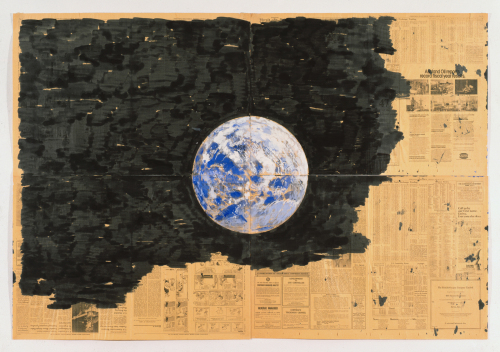
Image: Paul Thek, Untitled (EarthDrawingI), 1974
That a curator of a major international show could express such a wild thesis on the state of contemporary society says something about how acceptable such ultra-subjective, pessimistic observations are to current cultural and political anxieties towards a world in which events appear out of our control. Fogle's use of language is itself revealing of a sense of passive, helpless - essentially agentless - acceptance, in which events happen to us, while we are also simultaneously the perpetrators - yet the hyperbole is fixed on an altogether prosaic, real-world experience:
The question ‘Is there life on Mars?' is a rhetorical one posed in the face of an increasingly accelerating world, in which global events, at once political, social, natural, and economic, seem to challenge and threaten to overtake our most basic forms of everyday existence.6
Impending disaster, it seems, is only a curatorial flourish away. With Life on Mars, the thematic of disaster is bound up to a profound anxiety about the disorientation of the contemporary subject faced with uncontrollable change. Suspended metaphorically between Mars and Earth - the subject of Life on Mars becomes a ‘metaphorical quest to explore what it means to be human in this radically unmoored world'.
Why the world should be any more radically unmoored than at other times in history is never made clear. But if in Life on Mars the dislocation of the contemporary subject is couched in a spatial metaphor, After Nature generates a similar existential crisis in terms of history, yet again pointing to contemporary political and social reality in terms which are distinctly apocalyptic. Curator Massimiliano Gioni's introductory essay is titled with a quote from Blaise Pascal: ‘The collapse of the stellar systems will occur - like creation - in grandiose splendor'; a suitably vast and inhuman terminus to any sense of temporal progression.7 After Nature takes its title from W.G. Sebald's eponymous poem triptych, and much of its rhetorical inspiration from Werner Herzog's 1992 film Lessons of Darkness, and the result is an insistently post-historical, (or post-apocalyptic) vision of human life:
Many of the artworks and artefacts in this show ... might recall the relics of a lost civilization. Enclosed in vitrines, captured on film, or sketched with charcoal, they could be the mysterious findings of some ethnographer, or the experiments of a scientist desperately trying to save the last remnants of this planet, while documenting its imminent collapse. [...] It is a land of wilderness and ruins that exists in an imaginary time zone suspended between a remote past and a not-so-distant future.8
We're back onto the territory of the ethnographer, of the archaeologist and the conservationist who is, implicitly, beyond, or outside, of our own historical moment - the ‘Other' to our own present-bound experience. But whether cast as aliens from another planet or men from somewhere in the future, these displacements invariably seek to position our contemporary culture as something itself already alien - something that we should in some way treat with self-conscious distance or with distrust. With Martian Museum, it is the distrust of the ‘hubristic' Western subject, even when it paradoxically has to shore up that Eurocentric gaze by the deliberate exclusion of the contemporary non-Western artist. In Life on Mars, the destructively displaced and spatialised multiplicity of cultural identities and positions, and the out-of-control character of contemporary experience are counterposed with works of melancholic and pacific reflection on the intangible and inhuman immensity of the cosmos. With After Nature, time and history are both post- and pre- modern. This pre-/postmodernism is an explicit anti-modernity, which, when not obsessed with the before/after exclusion of humanity under the sign of ecology, admits human subjectivity only via the mystical, the sacred and the religious: ‘Many artists in this exhibition seek a prophetic intensity,' Gioni writes, ‘... fascinated by mystic apparitions, arcane rites, and spiritual illuminations.' Intoxicated with his theme, he declares that:
what these artists share is [...] a desire to charge art with a magical power, invest it with contents and forms that are meant to contrast its secularization, and aim at bringing it back into a sphere that is, if not religious, at least sacred or obscure, like a mystery cult.9
Here, Martian Museum catches up with After Nature, as they both endeavour to ‘depict a humanity caught in cryptic rituals or in adoration of mysterious divinities'.
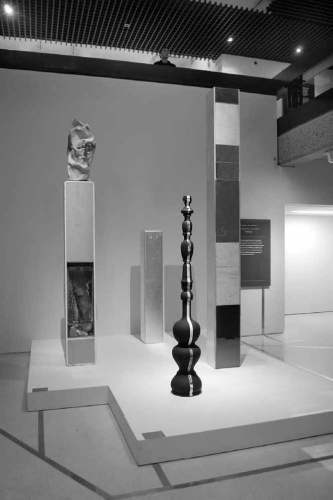
Image: ‘Totems’ section of The Martian Museum of Terrestrial Art
Cults and cryptic rituals also abound in The Institute of Psychoplasmics, although Pil and Galia Kollectiv mobilise the notion of the cult to more critical ends. Working outfrom David Cronenberg's 1979 film The Brood, the Kollectiv's project approaches the figure of the cult as a strategy to question the problem of political otherness and differentiation within the social body of capitalism:
If there is no outside to an ever absorbent Capitalist regime, art has no grounds from which to critique it. Religion increasingly seems to offer a way out of the impossible dialectic of outside and inside that Capitalism proposes. Art takes on a similar role, allowing for a limited externality to emerge within a social body whose unlimited expanse is equated with the expansionist project of global Capitalism.10
‘If there is no outside' is, however, a pretty big ‘If'. But it is in this that the figure of the Other - even for would-be radicals such as the Kollektivs - takes on its full contemporary significance. To argue that religion and art might be a way out of a totalising Capitalism would seem a peculiar argument to earlier generations of revolutionaries, for whom capitalism was necessarily historically contingent, and anyway already riven by an internal dialectic in which the Other might have been the agency of class, and the Subject the proletariat. But let's not dwell on bygone Grand Narratives. That one can suggest that there is no outside to Capitalism is a partial symptom of the disappearance of the narratives of the revolutionary Subject. The fall-back to art, and art which mimics the cultish religious refusal of liberalism's totalising community, is a sad shadow of the dynamic of earlier political divisions - the dialectical energy of the revolutionary historical Subject reduced to a frozen, mute abstentionism.
It's also telling that The Institute of Psychoplasmics combines an (almost) ironic affection for the forms of cultish community with a more extreme allegiance to an effectively post-human subject. The reference to The Brood is not idle - Cronenberg's film about an extreme psychotherapy group, in which the patients' emotional states become physically expressed, chimes with the various fantasies of a libidinally liberated post-human body - from Diann Bauer's miniaturised figures to Seth Coston's paintings of suited men who erupt with multiple phallus tentacles - in which the Cartesian mind-body division is comprehensively dissolved. ‘The Head is Nothing Without the Body' declares a work by Amanda Beech, and human heads are indeed hard to find in The Institute of Psychoplasmics - a fashionable Acephalism that shows how far the post-structuralist critiques of the Subject have become engrained in both liberal and radical thinking. One might be tempted to reply that there is of course ‘no-body without a head'. The Institute of Psychoplasmics resorts to the Cult as a fantastical absolute Other to the political Subject of a Capitalism that can no longer be transcended, but it also harbours a more profound - and conventional - desire to be absented from the Human itself.
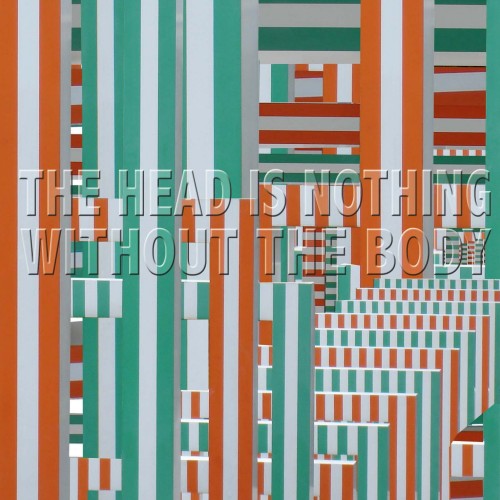
Image: Amanda Beech, The Head is Nothing without the Body, Triptych(1of3), 2007
What unites these shows is that they are each symptomatic of a complex disquiet about the nature of human experience and human subjectivity in an epoch in which the claims of the humanist, universalising Subject appear exhausted and discredited, and in which those human-centred, progressive narratives of human society and subjectivity have all been dismissed. What lies beneath Martian Museum's superficial critique of the ‘Western' subject is really the rejection of the notion of a potentially universalising Subject that transcends the ‘difference' of any given cultural subject. In Life on Mars and After Nature, the apprehension that contemporary society has abandoned any claim to progressive historical agency, and any progressive narrative of human history, manifests itself in each show's peculiar characterisation of the experience of history, in which active human agency has been removed. In Life on Mars this appears in the figuring of reality in terms of an anxious and essentially incomprehensible, never-ending present, to which we are helplessly subject. With After Nature, it is contained in the vision of a pre-/post-historical world in which humanity has become extinct, or at most has retreated to pre-modern, pre-secular and pre-rational forms of subjectivity. And with The Institute of Psychoplasmics, the apprehension of a naturalised, totalising and ahistoric Capitalism leads to a semi-ironic retreat to the cultish and the inhuman, as strategies to escape the problem of an apparently undifferentiated and unchangeable political stasis.
Such curatorial anxieties are neither that unusual nor coincidental. After all, the dissolution of the humanist Subject has been the mainstay of post-structuralist philosophy and theory for a generation. Daniel Birnbaum is no fool when, in his contribution to the Life on Mars catalogue, he variously draws on Deleuze, Foucault and Kojève to point to ‘new modes of subjective life'. He ends up in the post-historic and the post-human, of course:
What is Man and what is Animal today? What are the distinctive features of life after History, and who are we, breathing this posthistorical air, taking advantage of the lightness, and writing the postscript to historical Man?11
To tell ‘us' who ‘we' are, Birnbaum coopts Kojève, in his lecture on Hegel's Phenomenology of Spirit:
The historical process of work and negation, as analysed by Hegel and then, in a different fashion, by Karl Marx, is what turned the animals of the species Homo sapiens into humans, but this process has come to a close. We have reached the end of History yet, it seems, we are still around. Kojève goes on: The disappearance of Man at the end of History is not a cosmic catastrophe.12
The now-orthodox heresies of post-structuralism's assault on the humanist Subject might be fine for the theory class, but they now combine with the conservative theme of the ‘end of History', and the cultural and political consequences are novel and unpredictable. If post-structuralism has been declaring, for the past three decades, that Man is ‘over', then it is not surprising that other bugbear of anti-humanism, the dialectic of History, should be declared ‘over' too. Yet, it seems, ‘we' are ‘still' around.
Let's not blame curators for reproducing intellectual trends out of their control. That such big shows express similar perspectives merely reveals that they chime with the zeitgeist, in which the theoretical dismantling of the Subject now starts to intersect with a more general mood of cultural exhaustion and political terminus. The continued motif of the ‘Other', and the scrutiny of humanity from its position is necessarily a fantasy, but it signals how estranged from the concept of a centred Subject - psychological, social, historical - we now find ourselves. As James Heartfield argues in his The Death of the Subject, Explained:
Like the concept of the posthuman, the elevation of the Other corresponds to a degradation of the Subject. The desire to relinquish the Self, leave the species, stop persevering in one's being are all essentially the same death-wish.13
Or as the humanist writer Josie Appleton has recently observed:
Everywhere there is a discomfort with seeing things from a human point of view, or pursuing human interests. Indeed, it seems that we would rather see things from any point of view but our own, and defend any interests other than our own. This appears not as a craven attitude to the gods, but a craven attitude towards nature... ‘Anthropocentrism' has become a dirty word, spat out along with ‘humanocentrism', homocentrism and ‘humanism'. Indeed, to see the world from a human point is ‘speciesism'... Instead, theorists hunt around for other loci of value: ‘zoocentrism', ‘ecocentrism', even ‘cosmocentrism'.14
One doesn't have to go far to make the connection between the philosophical ‘degradation of the Subject' and the pursuit of ‘other loci of value' which deny a human point of view, nor are they hidden in these curatorial outings. The point of view of the alien, of the inhuman, of the pre- and post-historical, the mythical, and the ecological become the subjects for a world view in which humanity sees itself as other. And among these there is no better, nor more influential, manifestation of this self-estrangement of human subjectivity than the position of environmentalism. One might argue that environmentalism finds itself the true heir of post-humanism and the end of History, given that under its sign, humanity becomes Other to environmentalism's Subject - Gaia, the ecosphere.
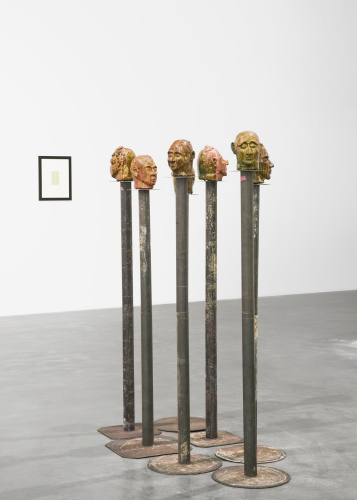
Image: Thomas Schütte, The Magnificent Seven, 1993
The philosophical paradox here is that such reversals of the Other actually return us to the universal human Subject, but in negative form. This Other humanity is seen as a single entity or identity, yet these melancholic dystopias in which humanity is observed as a specimen or a relic are necessarily the projection of human subjects, and we do not ‘stop perservering in our being' even though we attempt to theorise ourselves out of existence. But this philosophical paradox goes hand in hand with political terminus: These are not cultural, ethnic, social or political Others, Others that might be susceptible to encounter, dialogue, negotiation, and through that process - the active agency of human politics and history - the overcoming of that Otherness. This is instead an absolute Other, the human seen (by itself) as passive object, rather that active Subject. And it is here that the post-human meets the post-political. If it appears on one hand as if the world is out of our control, that we are the victim of forces we have no influence over, then it also appears that ‘we' are unstoppably destroying it on the other - nowhere in this is there a sense of active, purposeful human agency. If this is a consequence of the death of ‘Grand Narratives' then the engine of those narratives, the human Subject, is clearly on the verge of extinction, and from then on, we have little else to do than to muse about our own post-humanity and wait for the Apocalypse. The cultural melancholia expressed in shows from Martian Museum to After Nature points us to the novel political problem of making sense of what we mean by, and expect of, human subjectivity and human agency; of whether we want to develop new terms on which to remake the human Subject, or instead disappear into the vague hinterlands of the Other.
Info
Martian Museum of Terrestrial Art: Barbican Art Gallery, London, 6 March - 18 May 2008
The 55th Carnegie International: Life on Mars, The Carnegie Museum of Art, Pittsburgh, 5 March 2008 - 11 January 2009
The Institute of Psychoplasmics, Pump House Gallery, London, 9 April - 26 May 2008
After Nature, The New Museum, New York, 17 July - 21 September 2008
Footnotes
1Francesco Manacorda, Martian Museum of Terrestrial Art, London and New York: Barbican Art Gallery and Merrell Publishers, 2008, p.10.
2Graham Sheffield and Kate Bush, Martian Museum of Terrestrial Art, op. cit, p.8.
3Gilane Tawadros and John Gill, ‘We are the Martians', in Gilane Tawadros, John Gill and Jens Hoffmann, Alien Nation, London: ICA and InIVA, 2006, p.1.
4Douglas Fogle, ‘Is there Life on Mars?', in ed. Michelle Pirano, Life on Mars: 55th Carnegie International, Pittsburgh: Carnegie Museum of Art, 2008, p.21.
5Ibid. p.27.
6Ibid. p.29.
7Massimiliano Gioni, catalogue essay, After Nature, New York: New Museum, 2008, unpaginated.
8Ibid.
9Ibid.
10Pil and Galia Kollectiv, introduction, The Institute of Psychoplasmics, London: The Pump House Gallery, 2008, p.6.
11Daniel Birnbaum, ‘On Human Nature', in Life on Mars, op.cit. p.57
12Ibid.
13James Heartfield, The Death of the Subject, Explained, Sheffield: Sheffield Hallam University Press, 2002, p.67.
14Josie Appleton, ‘Recentring Humanity', in ed. Dolan Cummings, Debating Humanism, London: Societas Imprint Academic, 2006, p.93.
J.J. Charlesworth <jjcharlesworth@artreview.com> is a freelance critic and reviews editor at Art Review magazine. He is a member of the Manifesto Club's Artistic Autonomy group
Mute Books Orders
For Mute Books distribution contact Anagram Books
contact@anagrambooks.com
For online purchases visit anagrambooks.com


